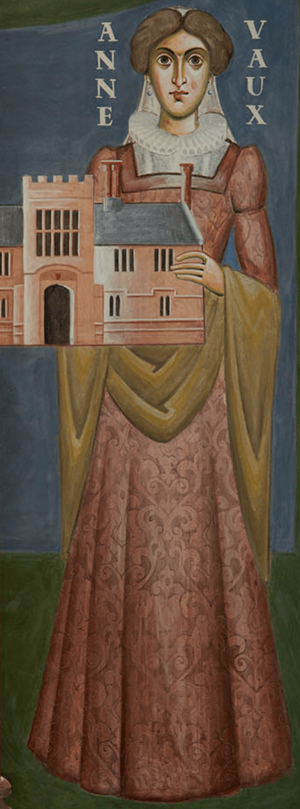Anne Vaux facts for kids
Quick facts for kids
Anne Vaux
|
|
|---|---|

A fresco of Lady Anne Vaux which resides at the St. Francis of Assisi Catholic Church in Baddlesey Clinton, Warwickshire.
|
|
| Born | c. 1562 |
| Died | In or after 1637 (aged about 75) |
| Noble family | Vaux (by birth) |
| Father | William Vaux, 3rd Baron Vaux of Harrowden |
| Mother | Elizabeth Beaumont |
Anne Vaux (born around 1562 – died in or after 1637) was a wealthy English Catholic woman. During her time, people who practiced the Catholic faith were called recusants. This meant they did not follow the official Church of England. Anne was known for helping Catholic priests.
Contents
Who Was Anne Vaux?
Anne Vaux was the third daughter of William Vaux, 3rd Baron Vaux of Harrowden. Her mother was Elizabeth Beaumont. Anne and her sister, Eleanor Brooksby, were very supportive of Catholic priests. They helped by renting houses where priests could meet safely. One of these houses was called White Webbs, located in Enfield Chase. Several people involved in the Gunpowder Plot visited this house.
Helping Catholic Priests
Anne Vaux was especially dedicated to Father Henry Garnet. He was a Jesuit priest. Father Garnet was later involved in the Gunpowder Plot. Anne was also related to Francis Tresham, who was one of the plotters.
The Gunpowder Plot Mystery
Both Anne Vaux and Francis Tresham have been thought to be the person who wrote a secret letter. This letter was sent to William Parker, 4th Baron Monteagle. It warned him to stay away from Parliament on November 5, 1605. This was the day the Gunpowder Plotters planned to blow up Parliament.
Lord Monteagle gave this letter to Robert Cecil, 1st Earl of Salisbury. The letter was very important in stopping the plot. No one knows for sure who wrote the letter. Some people think Anne Vaux wrote it. This idea is based on how her handwriting looked similar to the letter.
After the Plot Discovery
Anne Vaux suspected that the Gunpowder Plot existed. However, she was not directly involved in the plan itself. She was arrested soon after the plot was discovered. But she was later released.
After her release, Anne tried to hide Father Garnet. She took him to the home of Thomas Abington in Hindlip, Worcestershire. But Father Garnet was found and arrested on January 25. Anne then traveled to London. Father Garnet was held in the Tower of London. Anne tried to send him secret messages. She wrote these messages using orange juice on letters. These letters were given to Father Garnet's jailer.
The messages were sent to Salisbury. Anne Vaux was arrested again in March 1606. During questioning, she said she was innocent of any serious wrongdoing. But she did admit to letting plotters stay at her houses. She was released in August of that year.
A New School and Later Life
After her release, Anne Vaux moved to her sister Eleanor's family estate in Leicestershire. In 1625, she was found guilty of being a recusant. This meant she did not attend the official church services.
After her sister's death, Anne moved to Stanley Grange in Derbyshire. There, she started a school for boys from Catholic noble families. The authorities, who were Protestant, tried to close the school in 1635. Anne Vaux died in 1637 or sometime after that year.

